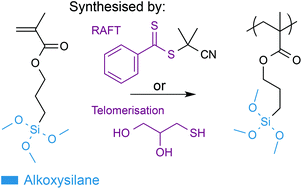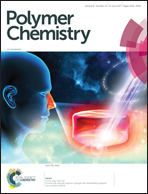Silica/methacrylate class II hybrid: telomerisation vs. RAFT polymerisation†
Abstract
Inorganic–organic co-networks prepared by a sol–gel method are a promising class of materials due to their unique physical and biological properties, especially when covalent bonds are formed between the networks. The polymer structure and composition can have a drastic effect on the synthesis and properties. Here, we compared reversible addition fragmentation chain-transfer (RAFT) with telomerisation (TL), for the synthesis of the polymer, to investigate whether refining the polydispersity of polymethacrylate could lead to better and more tailorable properties. 3-(Methoxysilyl)propyl methacrylate was used as a model and successfully synthesised by RAFT and TL using 2-cyano-2-propyl benzodithioate and thioglycerol as chain transfer agents, respectively. The polydispersity of the polymer had a significant effect on the sol–gel process with an increase in gelation time as the polydispersity decreased. Direct correlation was made between the gelation time and Mz, suggesting that the gelation of hybrids followed the percolation model. However, regarding the properties, it is a tie. No statistical difference in silica release and mechanical properties of the resulting hybrids was observed, regardless of the polydispersity of the polymer.



 Please wait while we load your content...
Please wait while we load your content...